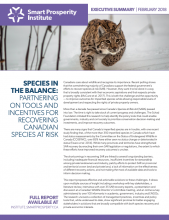February 10, 2018
The overwhelming majority of Canadians want species at risk populations to recover - but population trends are sobering and will persist without intervention from policymakers. Smart Prosperity Institute and the Institute of the Environment at the University of Ottawa have authored an in-depth report on improving species at risk conservation in Canada, with financial support from the Schad Foundation, Earth Rangers, Environment and Climate Change Canada (ECCC), the Forest Products Association of Canada (FPAC). The report draws upon multiple sources of insight including a workshop with key stakeholders, a literature review, interviews with SAR recovery experts, and an online survey administered to over 100 informants in academia, government, industry and ENGOs.
The report diagnoses a number of problems facing species at risk recovery work in Canada, including inadequate financial resources, insufficient incentives for stewardship among private landowners and industry, patchy efforts to protect SAR on provincial and territorial crown land and private land, and not making the most of available data and tools to inform decision making. The report provides actionable solutions which outline how governments and other stakeholders can enhance recovery outcomes, including through greater use of economic instruments, multispecies and ecosystem-based approaches, establishing a comprehensive species at risk database to inform decision-making, managing cumulative effects, and using new funding tools for SAR conservation.
This report recommends that policymakers consider eight cross-cutting actions. They are:
1) Governments should fully implement existing SARA provisions (such as section 11 conservation agreements, safety net orders, and emergency orders). This would help ensure backstop protections to SAR on non-federal land and encourage private sector participation in SAR recovery.
2) Harness a suite of economic instruments to promote stewardship on private land and crown land. In the case of provincial and territorial crown land, establishing rigorous and precautionary offset policies for SAR is an important priority. These could be enabled through SARA’s permitting policy, parallel provincial/territorial permitting policies, or signed section 11 conservation agreements between federal, provincial, territorial and Indigenous governments, landowners and industry.
3) Our stakeholders identified three further areas where economic instruments and related tools have the greatest potential for cost-effective impact:
a. leveraging opportunities to restore degraded landscapes;
b. using economic instruments to protect CH on private land — including conservation easements and payment for environmental service schemes;
c. tailoring economic instruments to manage broader threats in the landscape, such as point and nonpoint source pollution and invasive species.
This being said, additional studies which explicitly evaluate how economic instruments affect SAR’s abundance and distribution, as well as the quantity and quality of their critical habitat, are essential. Ideally, evidence for the effectiveness (or lack thereof) of these instruments will come from policy interventions that are designed and implemented as experiments, or quasi experiments. Governments should explicitly prioritize these experimental approaches when funding SAR recovery actions.
4) Use place-based (multispecies and ecosystem) approaches as appropriate, to improve the biological effectiveness or cost-effectiveness of recovery strategies and action plans. In general, we find that most recovery strategies should continue to proceed on a single-species basis, while action plans should focus on place-based approaches. This being said, several opportunities remain for effective place-based recovery planning that are worth considering.
5) Enhance existing SAR conservation initiatives on private land by making government-funded stewardship programs more directed, flexible, and incentive-based.
6) Strengthen data collection, sharing, management and dissemination to improve multiple dimensions of SAR decision-making and program implementation. Federal, provincial, territorial and Indigenous governments, academic, industry, and civil society actors should develop a database that would be shared among all stakeholders collecting and housing data relevant to SAR management. This includes data on SAR population abundance and distribution, SAR ranges, habitat associations and critical habitat, signed section 11 conservation agreements, recovery actions implemented in recovery strategies, as well as projects triggered under section 73 of SARA or section 5 of the Canadian Environment Assessment Act (2012) (and successor legislation).
7) Complement project-level impact assessments with broader regional impact assessments — as recommended by the Federal Expert Review Panel on Environmental Assessment and currently under consideration by the federal government — to help address the assessment of cumulative effects for projects triggered under section 73 of SARA or section 5 of CEAA (2012). We discuss how the processes required to meet SARA’s legislative requirements, such as recovery strategies and action plans, can also make a positive contribution to these regional impact assessments.
We also propose an iterative process for assessing cumulative effects under SARA and CEAA (2012), in which project-scale impact assessments (and other information sources such as action plans) can inform regional impact assessments. These regional impact assessments can subsequently be used to inform future project-scale assessments, action plans, etc.
8) Finally, governments should strongly consider increasing overall funding for SAR conservation. These additional funds could be raised through a combination of innovative funding instruments and increased public expenditures. These resources should be guided by an ethos of prioritization and targeted towards action planning and incentives on private land.




